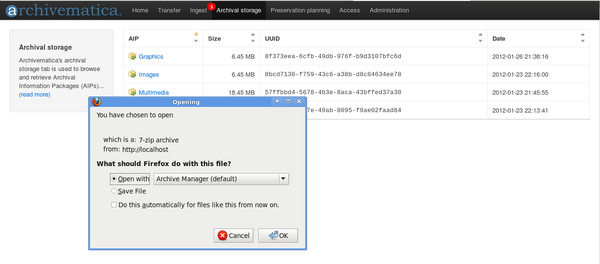Difference between revisions of "UM preservation planning"
Jump to navigation
Jump to search
(Created page with 'Main Page > Documentation > User manual > User manual 0.8 > Preservation planning') |
|||
| Line 1: | Line 1: | ||
[[Main Page]] > [[Documentation]] > [[User Manual|User manual]] > [[User manual 0.8]] > Preservation planning | [[Main Page]] > [[Documentation]] > [[User Manual|User manual]] > [[User manual 0.8]] > Preservation planning | ||
| + | |||
| + | == General description == | ||
| + | |||
| + | The ability to implement preservation plans is built into Archivematica. Archivematica's primary preservation strategy is to normalize files to preservation and access formats upon ingest. The preservation formats are added to the AIP and the access formats are used to generate a DIP for upload to the access system. Note that the original files are always kept, to allow for different preservation actions in the future, such as normalization to better archival formats or emulation. | ||
| + | |||
| + | == The Preservation planning tab == | ||
| + | |||
| + | #Once ingest is complete, selecting "Store AIP" in the Actions drop-down menu compresses and zips the AIP and moves it into Archival storage. [[Image:AIPsStoreg.png|600px|right|thumb|'''Figure 1''' AIPs stored in the default AIPsStore directory in quad-UUIDs.]] | ||
| + | #In the demo version of Archivematica the AIP storage directory is ''/sharedDirectoryStructure/www/AIPsStore/'' ('''figure 1'''). In other environments it can be a remote network mounted directory. | ||
| + | #The AIP directories are broken down into UUID quad directories for efficient storage and retrieval. | ||
| + | #The Archival storage tab in the Archivematica dashboard consists of a table with information about the stored AIPs ('''figure 2'''). Use the up and down arrows in the column headers to sort by AIP name, size, UUID or date. Note that at the bottom of the Size column is the total size of the stored AIPs. | ||
| + | #To open a copy of the AIP, click on the AIP name. You can then open or download the zipped AIP ('''figure 3'''). | ||
| + | #More information on Archivematica's AIP structure and the METS/PREMIS file is available on the Archivematica wiki: see [[AIP structure]] and [[METS]]. | ||
| + | [[Image:archivalStorage1g.png|600px|right|thumb|'''Figure 2''' The Archival storage tab showing the stored AIPs]] | ||
| + | [[Image:archivalStorage2g.png|600px|right|thumb|'''Figure 3''' A copy of the AIP opened from the Archival storage tab]] | ||
Revision as of 13:45, 27 January 2012
Main Page > Documentation > User manual > User manual 0.8 > Preservation planning
General description
The ability to implement preservation plans is built into Archivematica. Archivematica's primary preservation strategy is to normalize files to preservation and access formats upon ingest. The preservation formats are added to the AIP and the access formats are used to generate a DIP for upload to the access system. Note that the original files are always kept, to allow for different preservation actions in the future, such as normalization to better archival formats or emulation.
The Preservation planning tab
- Once ingest is complete, selecting "Store AIP" in the Actions drop-down menu compresses and zips the AIP and moves it into Archival storage.
- In the demo version of Archivematica the AIP storage directory is /sharedDirectoryStructure/www/AIPsStore/ (figure 1). In other environments it can be a remote network mounted directory.
- The AIP directories are broken down into UUID quad directories for efficient storage and retrieval.
- The Archival storage tab in the Archivematica dashboard consists of a table with information about the stored AIPs (figure 2). Use the up and down arrows in the column headers to sort by AIP name, size, UUID or date. Note that at the bottom of the Size column is the total size of the stored AIPs.
- To open a copy of the AIP, click on the AIP name. You can then open or download the zipped AIP (figure 3).
- More information on Archivematica's AIP structure and the METS/PREMIS file is available on the Archivematica wiki: see AIP structure and METS.


